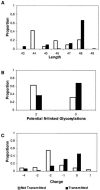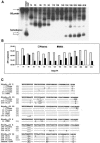Genetic analysis of simian immunodeficiency virus expressed in milk and selectively transmitted through breastfeeding
- PMID: 16571789
- PMCID: PMC1440429
- DOI: 10.1128/JVI.80.8.3721-3731.2006
Genetic analysis of simian immunodeficiency virus expressed in milk and selectively transmitted through breastfeeding
Abstract
To develop effective intervention strategies that prevent breast milk transmission of human immunodeficiency virus (HIV), we must understand the specific viral properties and mechanisms responsible for infant infection. We have used lactating rhesus macaques infected with a pathogenic simian immunodeficiency virus (SIV) stock to analyze the viral genotypes expressed in plasma and milk throughout the disease course and to identify those variants ultimately transmitted to infants through breastfeeding. In these studies we observed mother-to-infant transmission of SIV/Delta(B670) by eight females during the chronic phase of disease, and we analyzed by heteroduplex tracking assays and sequence analysis the distribution and fluctuations in viral genotypes expressed. Each female expressed multiple V1 envelope genotypes in milk near the time of transmission, while a single genotype was found in each of the infants. Variants transmitted to infants were not expressed throughout the maternal disease course but were only detected near the time of transmission. The emergence of the transmitted genotype in the dam typically occurred in plasma before milk and was coincident with increased milk viral loads. Transmitted genotypes tended to be longer and more glycosylated and had a less negative charge over the V1 region compared to viral genotypes expressed in milk but not transmitted. These observations demonstrate that specific viral genotypes are selectively transmitted to infants through breastfeeding and support the hypothesis that transmission occurs as genotypes adapt for efficient expression in milk.
Figures





Similar articles
-
Viral and immunological factors associated with breast milk transmission of SIV in rhesus macaques.Retrovirology. 2004 Jul 14;1:17. doi: 10.1186/1742-4690-1-17. Retrovirology. 2004. PMID: 15253769 Free PMC article.
-
Mother-to-infant transmission of SIV via breast-feeding in rhesus macaques.J Med Primatol. 2003 Aug;32(4-5):187-93. doi: 10.1034/j.1600-0684.2003.00024.x. J Med Primatol. 2003. PMID: 14498978
-
Genotypic selection of simian immunodeficiency virus in macaque infants infected transplacentally.J Virol. 1995 Dec;69(12):7982-90. doi: 10.1128/JVI.69.12.7982-7990.1995. J Virol. 1995. PMID: 7494311 Free PMC article.
-
Route of simian immunodeficiency virus inoculation determines the complexity but not the identity of viral variant populations that infect rhesus macaques.J Virol. 2001 Apr;75(8):3753-65. doi: 10.1128/JVI.75.8.3753-3765.2001. J Virol. 2001. PMID: 11264364 Free PMC article.
-
Protection of neonatal macaques against experimental SHIV infection by human neutralizing monoclonal antibodies.Transfus Clin Biol. 2001 Aug;8(4):350-8. doi: 10.1016/s1246-7820(01)00187-2. Transfus Clin Biol. 2001. PMID: 11642027 Review.
Cited by
-
Characterization of SIV in the oral cavity and in vitro inhibition of SIV by rhesus macaque saliva.AIDS Res Hum Retroviruses. 2010 Aug;26(8):901-11. doi: 10.1089/aid.2009.0235. AIDS Res Hum Retroviruses. 2010. PMID: 20672998 Free PMC article.
-
Altered immune responses in rhesus macaques co-infected with SIV and Plasmodium cynomolgi: an animal model for coincident AIDS and relapsing malaria.PLoS One. 2009 Sep 23;4(9):e7139. doi: 10.1371/journal.pone.0007139. PLoS One. 2009. PMID: 19774084 Free PMC article.
-
The gastrointestinal tract and AIDS pathogenesis.Gastroenterology. 2009 May;136(6):1965-78. doi: 10.1053/j.gastro.2008.12.071. Gastroenterology. 2009. PMID: 19462506 Free PMC article. Review.
-
The oral mucosa immune environment and oral transmission of HIV/SIV.Immunol Rev. 2013 Jul;254(1):34-53. doi: 10.1111/imr.12078. Immunol Rev. 2013. PMID: 23772613 Free PMC article. Review.
-
Early Sites of Virus Replication After Oral SIVmac251 Infection of Infant Macaques: Implications for Pathogenesis.AIDS Res Hum Retroviruses. 2018 Mar;34(3):286-299. doi: 10.1089/AID.2017.0169. Epub 2018 Jan 17. AIDS Res Hum Retroviruses. 2018. PMID: 29237287 Free PMC article.
References
-
- Amedee, A. M., N. Lacour, and M. Ratterree. 2003. Mother-to-infant transmission of SIV via breast-feeding in rhesus macaques. J. Med. Primatol. 32:187-193. - PubMed
MeSH terms
Grants and funding
LinkOut - more resources
Full Text Sources
Other Literature Sources
Medical

